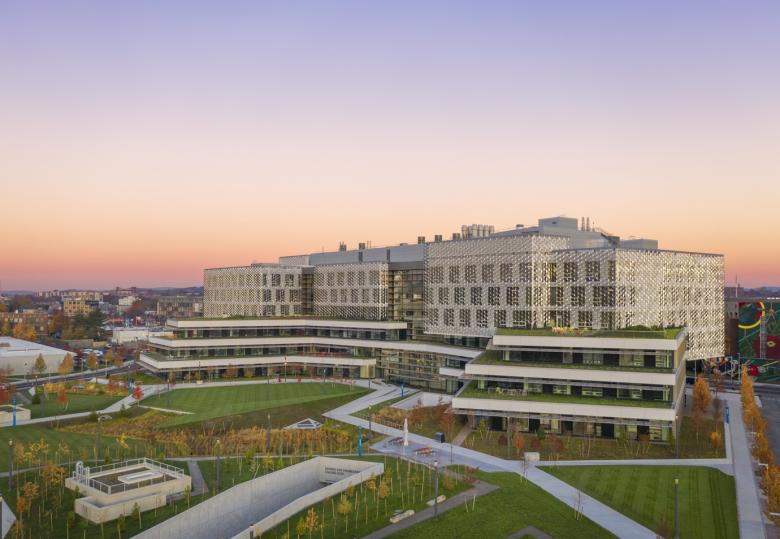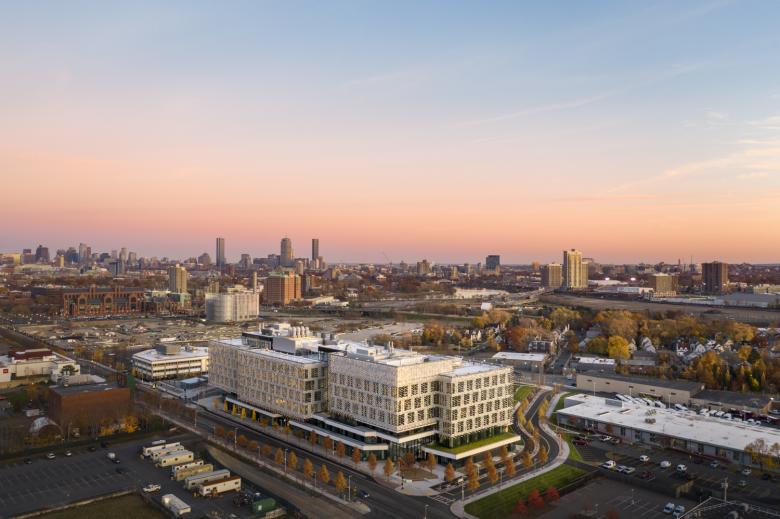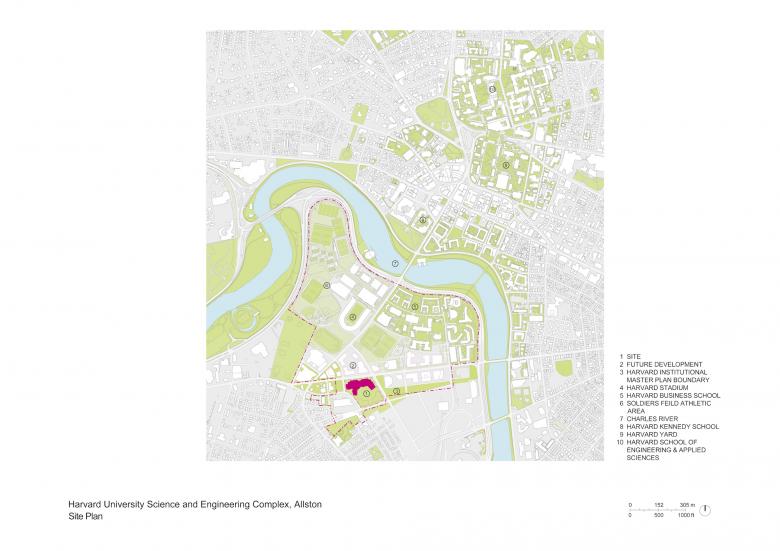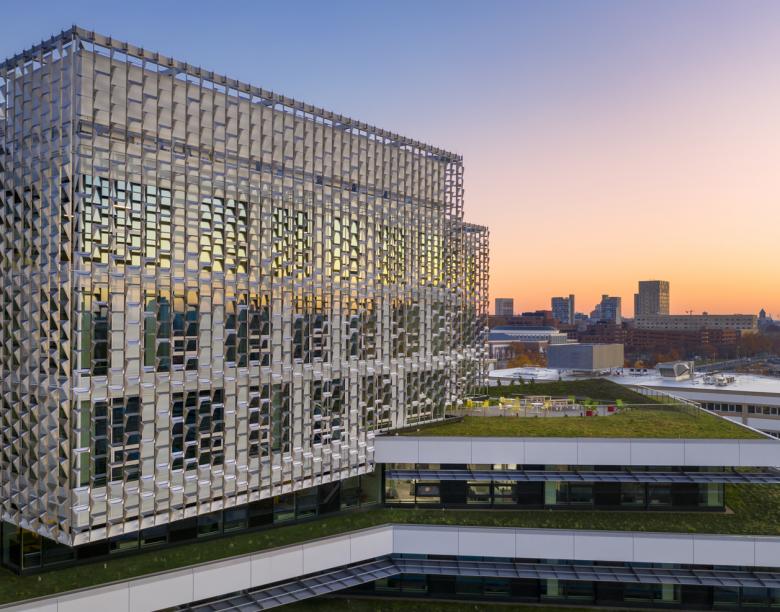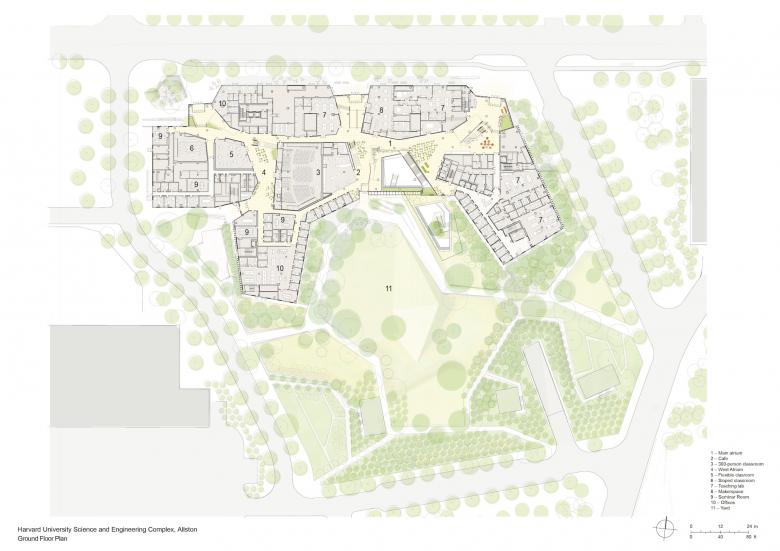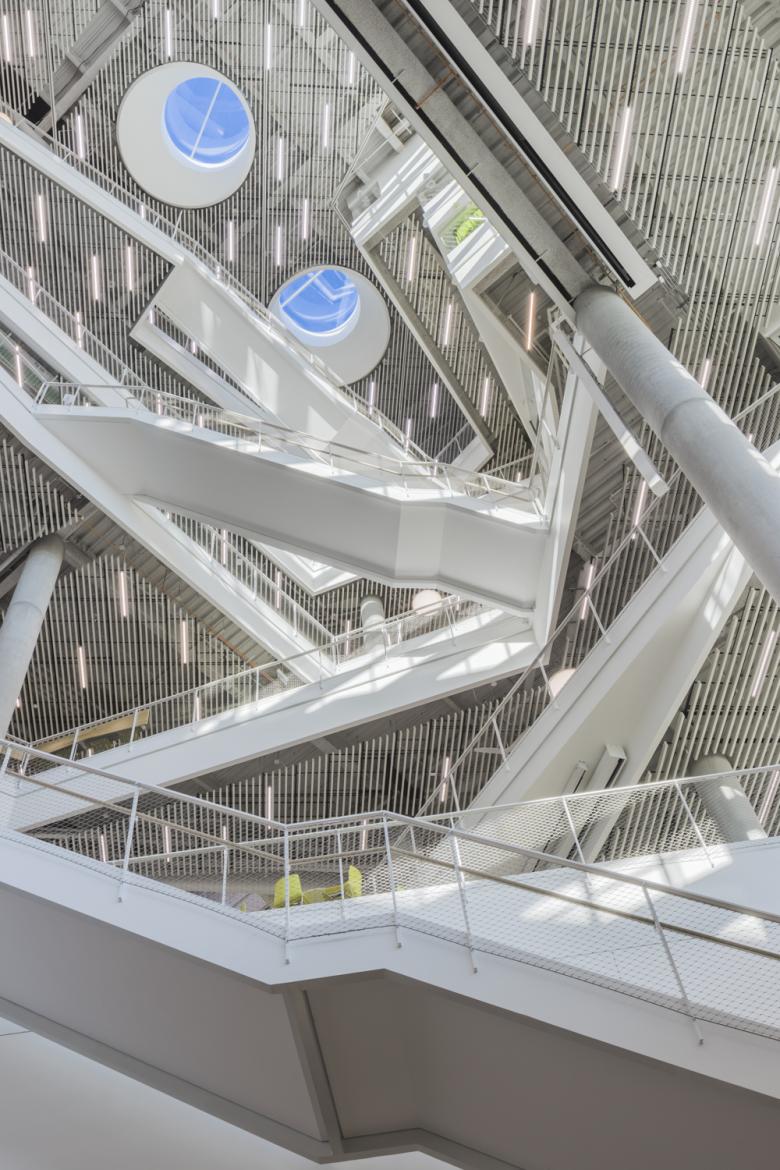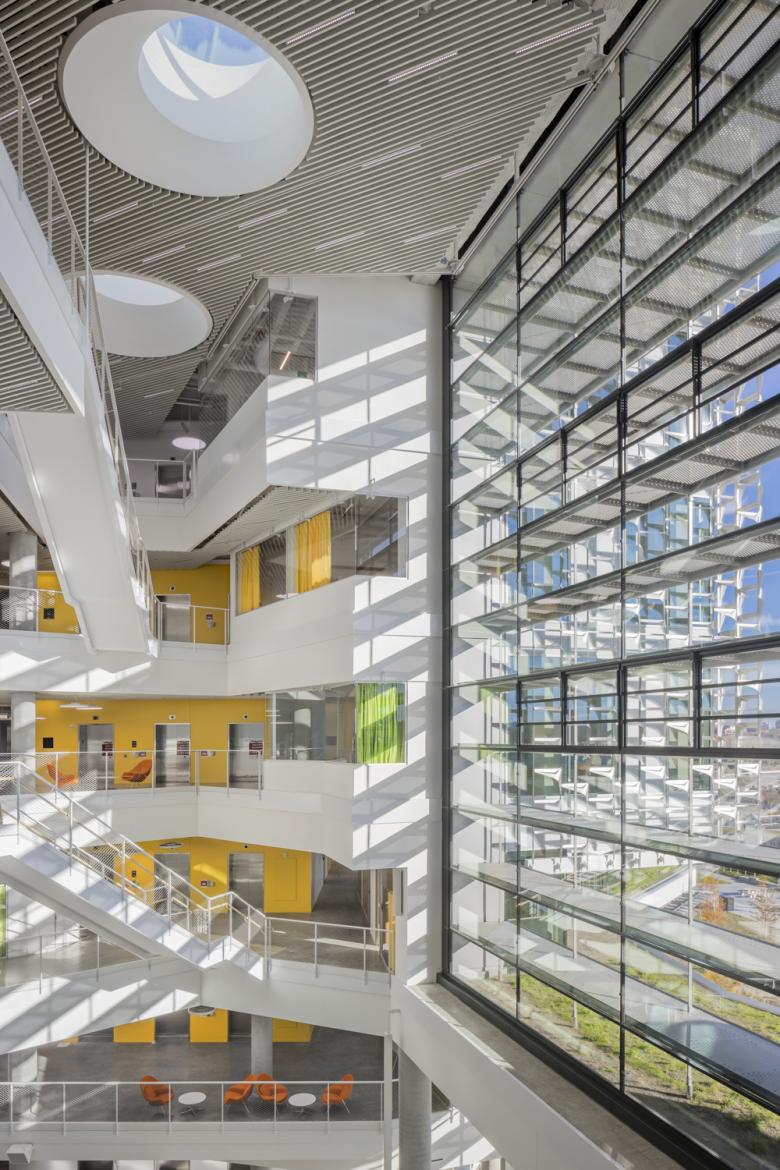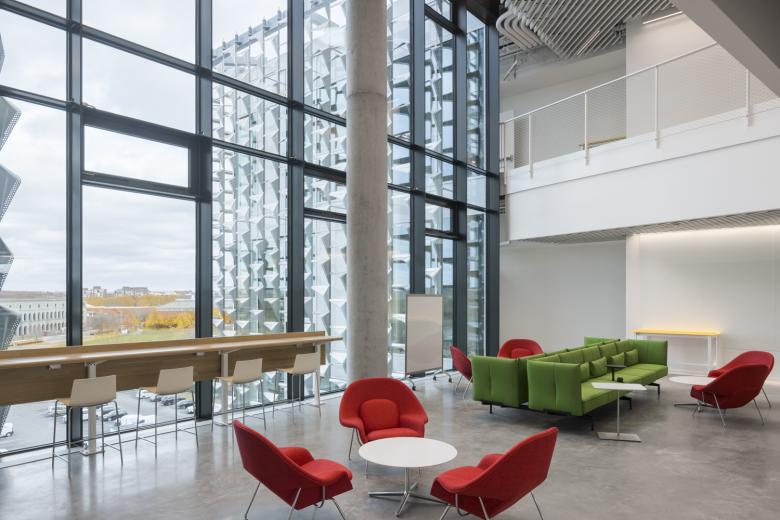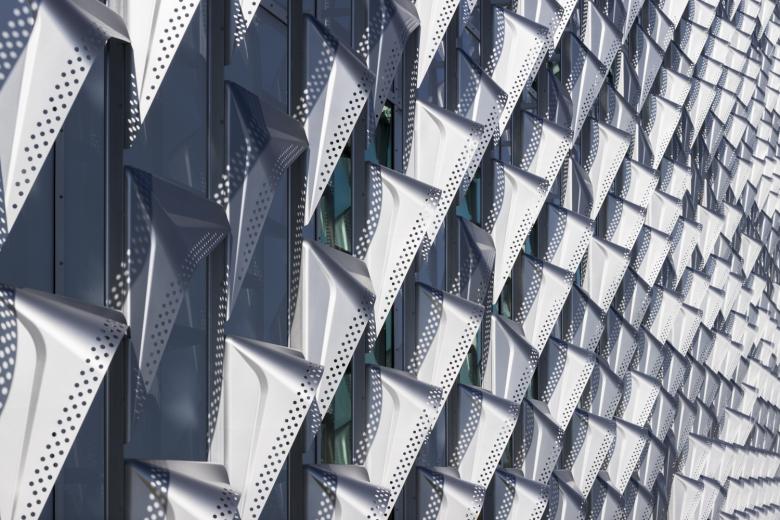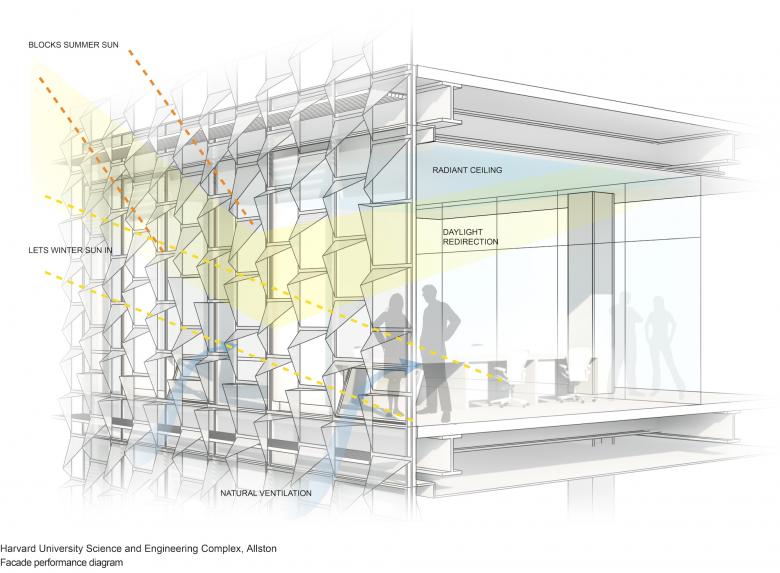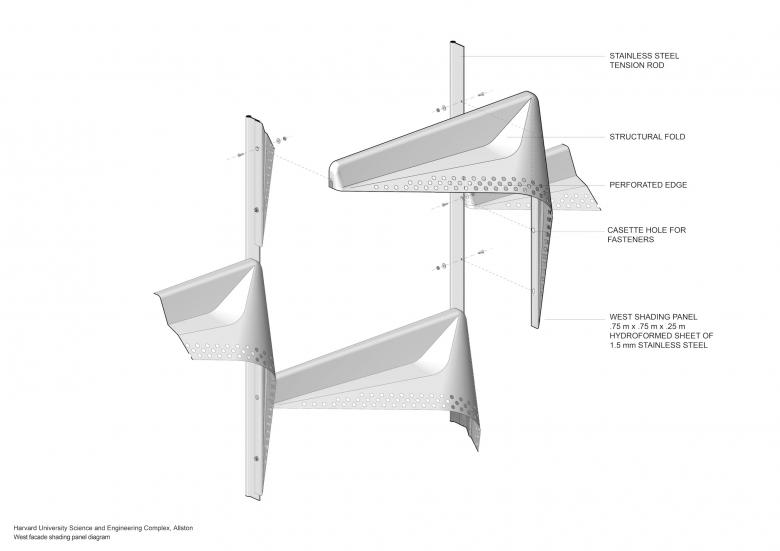No Place for Nerds
Ulf Meyer
21. July 2021
Photo: Brad Feinknopf
Harvard University’s new Science and Engineering Complex in Boston, designed by Behnisch Architekten, has a LEED Platinum certified from the USGBC and a Living Building Challenge Petal certification from the International Living Future Institute, making it one of the healthiest laboratory buildings in the world.
Harvard University’s new Science and Engineering Complex (SEC) serves both research and education, primarily housing labs and seminar rooms for the John A. Paulson School of Engineering and Applied Science (SEAS). The building was designed by Stuttgart’s Behnisch Architekten, the firm of Stefan Behnisch, who is no stranger to designing higher-education buildings in the United States.
Within that typology is one of his most famous buildings to date: the Genzyme Center in Cambridge, Massachusetts. Completed in 2004, it is an architectural icon of the life-sciences hype that occurred around the turn of the century. Almost twenty years later and not too far away from Genzyme stands Behnisch’s latest academic building of note. With the SEC, Behnisch has again created a building with an ambience that is, in the architect’s words, “supportive of studying, researching and teaching.”
The SEC is the first major building on Harvard’s new campus extension in Allston, west of Downtown Boston. (Photo: Brad Feinknopf)
Like all Behnisch-designed buildings, the Harvard complex wants to be seen as a sustainable, innovative and “healthy” building. “Extensive daylighting, robust sun shading and having operable windows everywhere, those are the standard hallmarks of Behnisch buildings, typically,” said Robert M. Noblett, who runs the firm’s Boston office and was partner-in-charge of the 544,000-square-foot project, the biggest Behnisch building in the USA to date. The depth of the floor plates, on average around 90 feet deep, is about twice of what it would be in a green building in Europe. “It was a research project for us architects as well,” Noblett said.
Heather Henriksen, the chief sustainability officer of Harvard University, put great emphasis on healthy indoor conditions and demanded that – on top a LEED Platinum certification – the building should achieve one of the petals of the Living Building Challenge (LBC): the “Materials” category for interiors. But where exactly to draw the line? The delineation of the interior had to be defined precisely, given that the “indoor air quality category had the most resonance with Henriksen,” Noblett said. To get the LBC certificate from the ILFI, some 5,600 products used in the building had to be screened for material declarations from 1,500 suppliers.
Harvard's Allston campus and main campus in Cambridge are on opposite sides of the Charles River. (Drawing: Behnisch Architekten)
It was the first time Behnisch had to deal with the tough LBC and Noblett called it “un-glamorous work,” which is probably an understatement. “But it still makes sense,” he told me, “because unlike LEED, which motivates building owners, this process addresses the construction industry.”
“Some manufacturers were simply baffled when asked for such detailed environmental documentation,” he added, “while other sources simply were LBC-compliant already.” Feasibly, now that the documentation work is done, it can lead to a bond between architect and supplier for future projects, even if they would not aim to be LBC-certified.
Noblett was worried for some time that his building might become “more bland” as a result of all the disqualifying paints and other materials they could not use. But elements such as floors and pieces of furniture made from reclaimed wood actually added character. The reclaimed wood was mixed with virgin wood, because “there simply were not enough barns torn down in the Northeast at the time to meet our demand,” said Noblett.
Green roofs cover the lower floors of SEC. (Photo: Brad Feinknopf)
All Harvard buildings need to be certified at least LEED Gold, but that is “slightly embarrassing” for Behnisch Architekten according to Noblett, because that threshold is “underwhelming.” He added: “When you are close to reaching Platinum, you want to go all the way.” And he did.
Away from ratings and challenges, usability, durability and beauty also key factors for sustainability as well, and it is here where the SEC also scores. Stefan Behnisch, the son of Germany’s most famous architect of the 1970s and 80s, Günter Behnisch, is known for designing spaces that nurture “collaborative work” with an architecture that is appealing, versatile and communicative. Behnisch’s approach is the opposite of a nerdy “mad professor.”
The upper floors of SEC have a metal mesh facade. (Photo: Brad Feinknopf)
The story of the SEC building dates back to the year 2006, when Behnisch Architekten won first prize in the architectural design compettion. The giant foundation for the building was poured but not completed and ultimately abandoned in 2008 during the financial crisis. The original idea was to build four separate life-sciences buildings on the giant common basement, but that plan was scrapped and large parts of the plinth mothballed. When the economic crisis was over, the university changed its mind regarding scale and use of the ruin. Behnisch took it from there and, some twelve years later, brought the project to a happy, single-building end.
The ground floor plan with Western Avenue on the north and the green space on the south. (Drawing: Behnisch Architekten)
At the Salk Institute in 1963, Louis Kahn had the idea that the architecture should encourage scientists to work across the confines of their disciplines, and that letting them gaze at nature’s beauty can relax their brains. The SEC functions similarly, but the Boston suburbs don’t have a powerful natural setting like the Salk and the Pacific Ocean, so Behnisch made do with a garden at the south end of the site as a focal point.
The landscaping on and behind the building and the connectedness of the interiors to the campus garden at the rear fit in with Harvard's “green” masterplan for its Allston Campus. The building has an urban facade that stretches along Western Avenue, the main drag of Allston. The elevation follows a rhythm that is broken into smaller units, disguising its true scale. Passersby can see students at work along Western Avenue, when their rooms are illuminated from within at dusk and at dawn.
The main atrium cuts through the whole height of the building. (Photo: Brad Feinknopf)
The SEC is composed of three volumes arranged around two atria; it is quite porous and “scooped-out,” as Noblett described it. The busy parts – auditoria, seminar rooms and a coffee shop – are placed on the first floor, with the labs and research rooms in discreet spots above. Toward the south the building extends its lower three floors, like “arms” that reach out into the rear garden.
The SEC building has a delicate fixed sunscreen facade that wraps around all four upper floors above the transparent two-story plinth. The stainless steel screen is shiny and reflective. The rooms designed for people are placed along one of the facades, and all offices have operable windows so that fresh air can enter the depth of the building.
The facade screens the sun entering the atrium. (Photo: Brad Feinknopf)
The seminar rooms come in different shapes and sizes: from semi-circular to classroom-like layouts. Labs for biology, chemistry, physics, optics and electronics are considered “wet,” while the computer labs are “dry.” The design separates areas with a need for high ventilation from those without. Lounges that spread across floors are designed as meeting points where scientist can relax, socialize, and gather.
Exposed concrete surfaces, glass and non-suspended ceilings with acoustic panels are combined with wooden floors, stairs and furniture to give the interiors some charm. The central atrium is as tall as the whole building. The western atrium can be used for events, while along the southern side the first three floors cantilever, creating green terraces towards the garden, which also acts as a rainwater storage.
The lounges are places for social interaction. (Photo: Brad Feinknopf)
The facade gives the great volume its identity and helps with energy efficiency. The brise-soleil panels act as horizontal sun blockers. The consulting firm Transsolar, also from Stuttgart, designed different facade systems that can integrate natural and lab ventilation. The labs have light stainless steel facade elements that create the world’s first “hydro-formed” facade system, which reduces cooling loads. Engineered by another Stuttgart firm, Knippers Helbig, the facade’s 12,000 panels in 14 shapes were manufactured by Josef Gartner (part of the Permasteelisa Group) using rapid prototyping. The simulation software CATIA helped the designers determine the shapes and thicknesses of the panels made from 1.5 mm sheets.
The facade is not kinetic, just geometrically complex. (Photo: Brad Feinknopf)
These steel sheets were folded for stiffness and perforated by a laser along the edges to reduce contrast. The panels are directly connected by vertical tension members anchored at each floor for rigid wind protection. The sizes and shapes of the panels correspond to their position in the triple-glazed façade – keeping the sun out of the interiors in the summer and letting it in in the winter, thus minimizing cooling loads and heating and lighting needs. The panels reflect daylight deeper into the building, while maintaining views, and flaps provide flushing at night. The dynamic appearance of the geometrically complex screens animates the elevations. The lower floors have ribbon windows with a floor-to-ceiling height. Two out of every three modules are fully glazed (with aluminum frames) while each third element is opaque.
The varied shapes of the facade panels correspond to summer and winter conditions. (Drawing: Behnisch Architekten)
The building also features inner facades around its atriums: the six-story central atrium has triple-glazing and sunscreens suspended from the roof. Overall, the facades are the “culmination of Behnisch’s thinking,” Noblett said, because they are static yet have all the benefits of a kinetic facades. The SEC takes the ideas behind the facades of previous major Behnisch buildings, such as the headquarters of Adidas and Unilever in Germany, one decisive step further.
The technique of folding steel sheets was created for the German auto industry. (Drawing: Behnisch Architekten)
Universities and other institutions are a good match for Behnisch Architekten, because these clients own their buildings long-term and thus benefit the most from energy savings. "Some of the technological and environmental behind Harvard’s latest building thinking are typically German,” Noblett said. While some parts such as an efficient heat recovery system were imported from Europe, others were not. For the acoustically detached ventilation system that Noblett wanted but did not want to have shipped across the Atlantic, he simply asked a local manufacturer to imitate it. Thus, the SEC building is an excellent example of a multi-disciplinary approach spanning borders.
